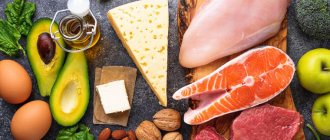Calorie intake per day
As such, there is no single and generally accepted daily calorie intake. According to the recommendations of the World Health Organization, “energy entering the body (in calories) must be balanced with energy expended.” Thus, your individual calorie intake depends, first of all, on the nature of your work, level of physical activity, gender, age and a number of other factors. However, on the Internet you can find many tables and calculators of unknown origin, offering information on daily values, supposedly based on authoritative sources. We believe that the quality of this information is quite questionable.
The most reliable way to determine individual calorie needs is to simply calculate the energy value of food consumed during the day (or several days). Just record your normal daily diet on paper. Write down what and how much you ate during the day. Calorie content can be directly calculated using information from product labels and using our website. Provided that you are healthy and your weight does not change much with your current diet, the results obtained can be conditionally considered your daily norm.
To lose weight, you need to slightly reduce your daily energy intake. If you maintain your current lifestyle, you will experience a slight calorie deficit because your costs will remain the same. This will lead to the gradual burning of your fat reserves. What exactly the deficit should be is up to you to decide. We strongly advise against increasing it sharply, because... it won't lead to anything good. Reduce your calorie intake gradually and lose weight slowly. This way you won’t have to torture yourself and break down from time to time. And of course, before making any dietary changes, we strongly recommend that you consult with your doctor or qualified dietitian.
Principles of developing a healthy diet
Tuesday, 15 June 2021
PRINCIPLES FOR FORMING A HEALTHY DIET
Individual needs for nutrients and energy vary significantly depending on gender, age, nature of work, physical activity, physiological state (pregnancy, breastfeeding), presence of disease, etc. However, there are scientific recommendations about the most common nutritional goals for modern humans.
These general nutritional goals, which all people should strive for when planning their individual food intake in order to maintain health and prolong active life and longevity, were formulated by the World Health Organization (WHO) (Table 5).
Table 5
Principles of optimal nutrition (WHO, 1991)
| Principles of optimal nutrition (WHO, 1991) Nutrients and products | Consumption thresholds | ||
| Lowest threshold | Highest threshold | ||
| Total fats, % energy | 15% | 30% | |
| Saturated fatty acids | 0% | 10% | |
| PUFA | 3% | 7% | |
| Dietary cholesterol, mg/day | 0 | 300 | |
| Total carbohydrates, % energy | 55% | 75% | |
| Complex carbohydrates, % energy | 50% | 70% | |
| Dietary fiber (non-starch polysaccharides), g/day | 16 | 24 | |
| Total dietary fiber, g/day | 27 | 40 | |
| Free (pure) sugars, % energy | 0% | 10% | |
| Protein, % energy*) | 10% | 15% | |
| Salt, g/day | unknown | 5 | |
| Raw fruits and vegetables, g/day | > 400 | ||
| Fish, g/day | > 20 | ||
| Nuts, grains, legumes, g/day | > 30 | ||
| Total caloric content: energy intake must be sufficient for the growth of children, for pregnant and lactating women, for achieving a certain level of performance and physical activity and for maintaining certain reserves in the body of children and adults. The body mass index of adults should be 20-22. *- fluctuations in the need for protein are due to its biological value. Proteins of animal origin (milk, meat, fish) are absorbed by 100%, vegetable proteins, depending on the type, are absorbed by 50% (wheat) - 80% (leafy greens, potatoes). | |||
Based on practical recommendations, you can provide the body with all the necessary substances, maintain health and lead an active lifestyle until old age.
SPECIALTY PRODUCTS
In addition to traditional (natural) food products, specially created fortified products are also used to optimize the diet (these are traditional products to which essential nutrients are specially added: vitamins, minerals, dietary fiber, etc. 15 to 50% of the daily requirement per 100 g or serving) functional foods and biologically active food additives.
The use is due to the fact that over the past decades, human energy consumption has decreased by 1.5-2 times. In proportion to this, it is necessary to reduce food consumption - otherwise overeating and excess weight are inevitable, which will lead to the development of diabetes, hypertension, atherosclerosis and other diseases. However, the average diet, designed for 2500 kilocalories per day, is deficient by at least 20-30% in most vitamins, minerals, flavonoids, etc.
Functional Products
– these are specially developed food products with a specified chemical composition (by eliminating, enriching or replacing nutrients and biologically active substances), energy value, and physical properties. These, for example, include products enriched with dietary fiber (including prebiotics), probiotics - microorganisms (bifidobacteria and lactobacilli), antioxidants, vitamins (A, C, E, etc.), minerals (calcium, etc. .), microelements (iron, zinc, fluorine, selenium, etc.), flavonoids (phytoestrogens, quercetin, etc.).
In addition to their high nutritional value, these food products have a pronounced physiological effect. The main directions of action of functional products are, for example, increasing physical endurance, improving immunity, digestive health, regulating appetite, etc.
Dietary supplements (BAA)
– a composition of natural (vitamins, minerals, amino acids, fatty acids, dietary fiber and other substances) or biologically active substances introduced into the diet in order to improve its value and enrich it with individual food components. Dietary supplements can be used in the diet to supplement nutrition with balanced complexes of vitamins, minerals, dietary fiber, etc.
Regular and targeted intake of dietary supplements can solve many problems. With their help, you can easily and quickly compensate for the deficiency of vital nutrients. They make it possible to individualize a person’s diet depending on gender, age, level of energy expenditure, characteristics of metabolic status, and physiological state.
With the help of dietary supplements, non-drug regulation and maintenance of the functions of individual organs and systems of the body is carried out. Along with this, their use helps to increase adaptive potential under the influence of unfavorable environmental factors.
At the same time, dietary supplements are not drugs and cannot be treated with them. The very essence of dietary supplements comes from their name - they are food additives, that is, part of the daily diet.
They are used in nutrition:
• • as an additional source of food and biologically active substances (to enrich the diet with them);
• • to normalize and/or improve the functional state of organs and systems (including mild diuretic, tonic, sedative and other types of action);
• • as general strengthening products;
• • to normalize the microflora of the gastrointestinal tract;
• • to normalize protein, carbohydrate, fat, vitamin and other types of metabolism.
SOURCES OF CRITICAL NUTRIENTS
The content of critical nutrients in specific products depends on the technology of their production, the quality of raw materials, organoleptic properties, established expiration dates, established eating habits of consumers and can fluctuate significantly.
Based on an analysis of the structure of daily consumption for the main groups of food products in the Russian Federation, the average daily consumption was calculated and industrial food products were identified, which are the source of consumption of table salt, sugar, fats with saturated fatty acids and trans isomers of fatty acids (Table 8).
Table 8
Average daily consumption of industrial food products by the population of the Russian Federation, including the share of critically important nutrients
| Product Name | Average daily consumption, G | Share of critically important food | ||||
| substances by product groups, % | ||||||
| Salt | Sugar | Fat | ||||
| Bread products | 210 | 27 | 11 | 5 | ||
| Vegetables and fruits | 80 | 10 | 11 | 2 | ||
| canned food, juice products | ||||||
| Meat products | 80 | 35 | 0 | 23 | ||
| Fish products | 20 | 14 | 0 | 2 | ||
| Oils, fats | 30 | 0 | 0 | 30 | ||
| Dairy | 260 | 14 | 6 | 17 | ||
| Sugar, including confectionery products calculated as sugar | 90 | 0 | 72 | 21 | ||
Main food sources of critical nutrients in the diet
Sodium (Common salt):
bread and bread products, sausages and canned meats, cheeses, canned vegetables and pickles, salted and smoked fish products, and various combined products (sauces, ketchups, etc.).
The average ranges of table salt content in terms of sodium in the main food groups are shown in Table 9.
Table 9
Average Sodium Content Ranges for Major Groups
food products
| Product name | Sodium, mg/100 g | ||
| min | max | ||
| Bread products | 246 | 499 | |
| Canned meat | 400 | 800 | |
| Boiled sausages | 700 | 1000 | |
| Fresh sausages | 1500 | 2000 | |
| Canned vegetables and pickles | 600 | 1100 | |
| Canned fish | 500 | 700 | |
| Smoked and salted fish | 700 | 5600 | |
Added Sugars:
flour confectionery products, cakes and pastries, sweets, sweet fermented milk products and curd products, sweet soft drinks.
Average ranges for added sugars in major food groups are presented in Table 10
Table 10
Average ranges for added sugars
in main food groups
| Product name | Sugar, g/100 g | ||
| min | max | ||
| Cookie | 20 | 45 | |
| Candies | 48 | 84 | |
| Pastries and cakes | 16 | 55 | |
| Curd cheeses | 22 | 30 | |
| Yoghurts | 6 | 15 | |
| Soft drinks | 5 | 12 | |
| Juice products | 0 | 15 | |
Fats, including fats with saturated fatty acids and trans fatty acids:
products made using meat and dairy raw materials, confectionery, some types of fat and oil products and sauces.
Meat products,
such as sausages, frankfurters and sausages, deli meats, ready-made culinary products, semi-finished products and canned food, are positioned as a source of complete protein with high digestibility and biological value, at the same time they
are the main sources of fat.
The protein content in boiled sausages, frankfurters and wieners ranges
from 8% to 13%,
while the fat content ranges from
15% to 38%,
with the protein/fat ratio ranging
from 1:1.15 to 1:4.75,
although for For most boiled sausages
this ratio corresponds to 1:1.6-2.5.
Average ranges of fat content in major meat products are given in Table 11.
Table 11
Average ranges for fat content in major meat products
| Product name | Fat, g/100 g | ||
| min | max | ||
| Sausages, sausages | 18 | 33 | |
| Boiled sausages | 15 | 38 | |
| Sausages | 40 | 46 | |
| Premium sausages | 39 | 48 | |
| Fresh sausages | 22 | 56 | |
| Fresh meat delicacies | 47 | 69 | |
Dairy
- milk and fermented milk products (kefir, fermented baked milk, yogurt, curdled milk, etc.), sour cream, cream, cottage cheese, cheeses, etc. The main advantage of this group of products is the presence of high-quality and easily digestible protein, as well as calcium.
Average fat content ranges for major dairy products are given in Table 12.
Table 12
Average fat content ranges for major dairy products
| Product name | Fat, g/100 g | ||
| min | max | ||
| Drinking yoghurts + kefir line | 0,1 | 4 | |
| Spoon yoghurts | 0,5 | 4 | |
| Curd and yoghurt products | 0,1 | 5 | |
| Dairy desserts | 0,05 | 8,96 | |
| Cottage cheese | 0,1 | 9 | |
| Glazed cheese curds | 19,9 | 24,7 | |
In confectionery
depending on the composition of the components, the fat content reaches
39%.
The average ranges of fat content in basic confectionery products are given in table. 13.
Table 13
Average ranges for fat content in basic confectionery products
| Product name | Fat, g/100 g | ||
| min | max | ||
| Cookie | 9,4 | 23,6 | |
| Cakes | 16,2 | 38,6 | |
| Chocolate coated candies | 14,6 | 39,5 | |
| Chocolate | 30,3 | 35,5 | |
content with saturated fatty acids
in a food product is associated with the type of fat used in the production of food products: pork fat contains
on average 45%
fat with saturated fatty acids;
in beef - about 60%,
in dairy -
65%,
in chicken -
about 30%.
The content of fats with saturated fatty acids in meat products ranges from 3.3% to 11.6%
depending on the amount of fat and the type of raw materials used, with a significant share of the range of sausage products averaging
5-6%.
Dairy products with a fat level
of up to 10%
also contain
5-6%
fat with saturated fatty acids.
Trans fatty acid isomers
in food products can be of both natural origin and technological origin (formed from unsaturated fatty acids during the hydrogenation of liquid vegetable oils).
Trans isomers formed as a result of industrial processing of liquid oils significantly increase the risk of developing cardiovascular diseases, therefore their content in fat and oil products is an indicator of safety
and is strictly regulated.
In accordance with the requirements of the technical regulations of the Customs Union “Technical Regulations for Fat and Oil Products” (TPTS 024/2011), the content of trans isomers of fatty acids in fat and oil products should not exceed 2% (for hard margarines - no more than 20%).
Recommended levels of total daily dietary intake of critical nutrients (table salt, sugar, fats with saturated fatty acids and trans isomers of fatty acids), calculated from the standpoint of modern nutritionology, based on the results of numerous fundamental and epidemiological studies, are given in Table. 14.
Table 14
Recommended levels of total daily dietary intake of critical nutrients (table salt, sugar, fats with saturated fatty acids and trans fatty acids)
| Nutrients | Recommended daily intake level |
| Salt | < 5 g/day (or in terms of sodium 2000 mg/day) |
| Added sugar | <50 g/day (or <10% of calorie intake based on 2000 kcal/day) |
| Fat, including: | < 65 g/day (or < 30% of calorie intake based on 2000 kcal/day) |
| - with saturated fatty acids | <20 g/day (or <10% of calorie intake based on 2000 kcal/day) |
| — with trans isomers of fatty acids (except milk fat) | <2 g/day (or <1% of calorie intake based on 2000 kcal/day) |
When developing color schemes for labeling food products, ranking them in accordance with nutritional value and the content of critical nutrients, it is necessary to use the differentiated criteria given in Table 15, obtained by analyzing the average daily consumption of food products in the Russian Federation and the average values of critical nutrients.
Table 15
Differentiated criteria for classifying industrial food products as products with excess content of table salt, added sugar, fats with saturated fatty acids and trans isomers of fatty acids
| Nutrients | Excess level, g/100 g | Food products |
| Table salt [sodium] | >1,20 [0,48] >1,75 [0,70] | bread and bakery products processed meat and fish products |
| added sugar | >22,00 >7,00 | solid foods drinks, liquid and paste dairy |
| fat, including: | >18,00 >9,00 | meat products (with a protein content of at least 12%) curd products |
| - with saturated fatty acids | >5,00 | all product groups |
| — with trans isomers of fatty acids (except milk fat) | >2,0 | all product groups |
Provided the content of critical nutrients in food products is specified in Table 15 of the limits of values and with the existing consumption structure, the target levels of their daily intake from the diet will be achieved.
The material is compiled based on open Internet sources
Department for the organization of hygienic education and training
Step-by-step meal planning tips
How to properly plan meals for a whole week? Where to begin? Let's put everything on the shelves.
Step 1: Exploring the bins in the kitchen
First, go to the kitchen and explore all the hidden depths of your cabinets. Don't forget to also look in the refrigerator and freezer - this is where the most interesting finds are usually found. Make a list of the products you have on hand and figure out what you could cook with them.
Step 2: Making a list of dishes
Make a list of your favorite side dishes, soups and main dishes. This is necessary so that you don’t have to wonder what you can cook up so deliciously, but simply take a few ready-made ideas and distribute them in your planner
Step 3: Count calories (for those on a diet)
If you are calculating the number of calories and dietary supplements in one serving, write this data next to each dish so that it is easier to combine them later. You can also use mobile applications - fortunately, now there are enough of them and they automatically calculate the calories of a dish!
Step 4: Plan your meals for the week
Now let's move directly to the scheduler. Draw a calendar for the next week, where each cell will mean one calendar day. For each day, write down the names of the dishes you will prepare, looking at the list you compiled earlier.
Advice: distribute meals so that breakfast consists mainly of slow carbohydrates (porridge), lunch - carbohydrate-protein (broth, hot meat dishes, cereals or potatoes), dinner - vegetables and proteins (salads, fish, cottage cheese).
Step 5: Making a shopping list
You can leave a free column next to the calendar in order to plan all the necessary purchases. Write down there what products you need to prepare all the dishes you have planned, and allocate 1-2 trips to the store for this.
Don't forget to take your shopping list with you! This way you won’t miss anything or buy too much, which will save you money!
Step 6: Use Recipes
We're not going to cook the same dishes year after year, are we? For inspiration, stock up on a few interesting magazines with culinary recipes or bookmark a couple of proven portals on relevant topics. And gradually expand the list of your favorite side dishes and desserts!
That's it, our planner is ready!
Where to begin
How to start eating right to lose weight? First of all, a person who wants to lose weight needs to calculate the body mass index (BMI) using the following formula: BMI = weight (kg) / height (m)². Then the result should be compared with the table to understand how your body weight corresponds to the accepted norm and whether you need to lose weight:
Table. Body mass index
If the reading is 30 or more, it is recommended to consult a nutritionist, and if the reading is 40 or more, you should also consult an endocrinologist.
Next, you need to calculate the optimal daily caloric intake for weight loss using special formulas or using an online calculator. When calculating, take into account physical activity.
It is also recommended to keep a food and exercise diary. Write down what you ate today and what exercises you did. Analyze your diary, mark mistakes in red, believe me, you will want to correct them as quickly as possible.
Weekly menu for losing 10 kg weight for men
Having created a menu for the week, you will have the opportunity to purchase the necessary products in advance.
When selecting products, you must adhere to the basic principles of nutrition:
- 1 breakfast - complex carbohydrates
- 2 breakfast – fermented milk products + fruits + vegetables
- Lunch – complex carbohydrates, proteins, vegetables
- Afternoon snack – fermented milk products + fruits + vegetables
- Dinner – protein, vegetables
The most high-calorie food should be eaten at lunchtime. Be sure to have dinner at least 3 hours before bedtime. The intervals between meals should be the same, no more than 4 hours. By supporting your diet with physical exercise, you will quickly achieve the best results.
Physiologically, women are prone to more rapid formation of the fat layer. Therefore, the amount of fat they consume should be lower than that of men. A man's diet can include a moderate amount of sweets and quickly digestible carbohydrates; for women, it is better to exclude such foods. Don't forget to take water between meals.
Losing weight correctly
Serving sizes for men and women:
- Fish and meat – female portion 100 g, male portion 150 g
- Garnish – female portion 150 g, male portion 200 g
- Salad – for men and women – 150 g
- Fermented milk products - female portion 200 g, male portion 200-300 g
- Volume of liquid other than water – for men and women – 200 ml
The table shows one of the many menu options for men and women to lose 10 kg in a week. Depending on your preferences, you have the right to adjust it, adhering to the basic recommendations.
| Day of the week | Menu for men |
| Monday |
|
| Tuesday |
|
| Wednesday |
|
| Thursday |
|
| Friday |
|
| Saturday |
|
| Resurrection |
|











